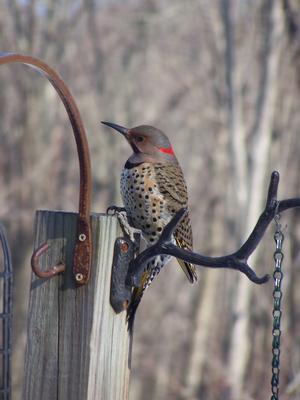
1. Flickers love ants... Here a female Northern Flicker has alighted momentarily atop a post adjacent to feeders on our deck
Part III: Swallows and Grosbeaks and Veerys, Oh My!
Many birds are primarily insect-eaters, with piercing vision they seek out prey, rapaciously gobbling larva and adults. The adage: “the early bird catches the worm” is more fact than fiction though it is anthropomorphism in reverse! Flickers love ants (see pic 1). Gregarious Barn Swallows (see pic 2) pick-off prodigious numbers of small flying insects from their flight paths in midair, chattering all the while. Nighthawks careen and swoop in the late day sky on pointed wings angled like boomerangs with an oval white patch at the crook of each under-wing, their signature mark. Nighthawks patrol the skies eating enormous quantities of mosquitoes, flying ants and other winged pests. Some, like the elusive nocturnal Barn Owl, buff brown and white, dine largely on rodents in cemeteries, abandoned lots and old farms. And though its wide-opened eyes are well-adapted for nighttime vision his sense of hearing is especially keen; a rustle in the leaves and the owl’s head automatically spins as if on a mechanical axis towards the direction of the sound.
Insects are an integral part of any properly functioning ecosystem. Well-rounded landscapes in which few or preferably no chemical weed controls, pesticides or fungicides are spread will draw more insects, the good, the bad and the fascinating. These, in turn, will attract the birds that feast upon them. A healthy, well-rounded landscape will also be a magnet to beneficial insects that will also help contain those that are deleterious.
Heavily-fed monocultures such as weed absent lawns are unnatural states. Monocultures, absent in nature are the fastidious contrivances of man. You will find many fewer insects and birds in such a green desert – the chemical agents that artificially keep the lawn looking healthy are a bane to all manner of life including the microscopic flora and fauna which naturally reside by the millions upon billions in every well-composed cup of healthy soil.
Many of you are old enough to remember Rachel Carson’s illuminating book, Silent Spring. During this period, in the late 1950s through the 1960s numerous bird species were noticeably declining. She deduced that chemicals such as DDT which were heavily applied in many venues were damaging the reproductive systems of many bird species. Eggs were formed without hard shells rendering them dead on arrival. Other pesticides were mutagenic causing reproductive systems in young birds to fail. Insecticides in a double-whammy also reduced the food populations upon which many insect-eaters fed. The green movement of the 1960s and ensuing decades has focused on chemical-free landscapes. This has set the stage for the return of many bird species that would feast upon the things that creep, crawl, bore and fly, including Bluebirds. It is logical that the greater the array of plants, both deciduous and evergreen grouped together sans the use of chemicals increase the opportunities for food – both insect and fruits. And greater the number of clustered plants provide shelter, nesting materials and nesting sites for your feathered inhabitants.
Handsome omnivorous Rose-breasted Grosbeaks nest in the lower branches of trees or in thickets. They construct their nests using small twigs and stems lined with hair, pieces of root and grass. An enormous help to farmers they relish larva, caterpillars, grasshoppers and potato beetles, insects forming half of their diets. But you can help them along by planting maple, dogwood and hawthorn as they also feast upon their seed. They especially fancy the developing seeds of wild cherry (Prunus serotina) which they pick out from the centers of dying blossoms.
I have observed sleek and pert Catbirds (see pic 3) with green larva dangling from their beaks warily looking about to be certain the coast is clear before disappearing into a dense thicket of evergreen hollies in which their hungry hatchlings await. But these same Catbirds enjoy a broad palette of fruit and seed as they devour dogwood, sumac (see pic 4), viburnum, highbush blueberry (Vaccinium corymbosum), hollies, cherry, spicebush (Lindera), blackberry (Rubus), mulberry (Morus) and red cedar (Juniperus virginiana).
Some birds are just plain wild; these you will likely never draw to a feeder. But understanding their habitat needs and availing it to them will increase your chances in keeping them nearby. The elusive Veery, another omnivore, with its distinctive and beautiful descending reed flute song in nearby woodlands at dusk feeds on many ground-hugging insects but is also partial to bountiful wild fruits. Though they may choose a low-lying shrub in which to build their nests they are normally ground-nesters laying their eggs in a hefty bowl of moss, leaves and plant fibers set in a clump of grass or ferns. Should you be fortunate enough to have them nearby in a wild verge then leave it be. Oftentimes by doing nothing you will have done a good deed! Though I almost never see them I would very much miss their incredible ethereal voice at summer vespers. Stay tuned.

